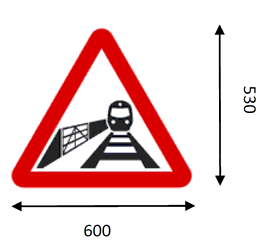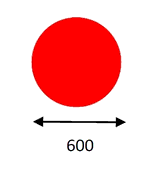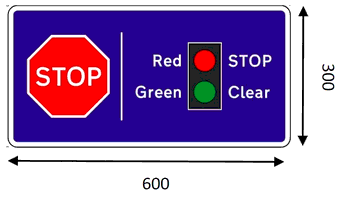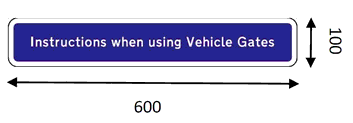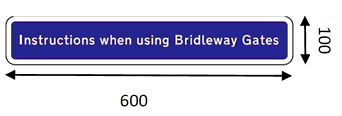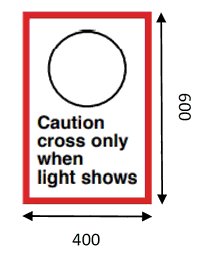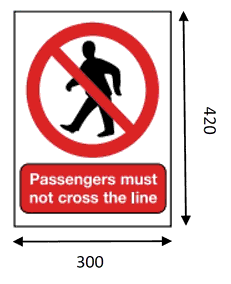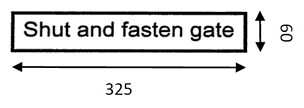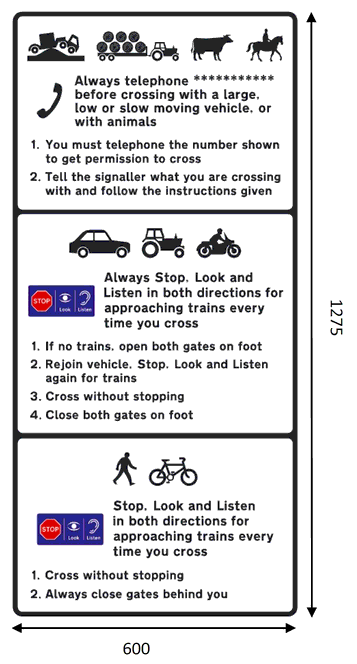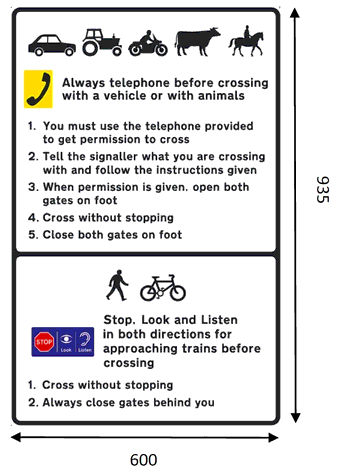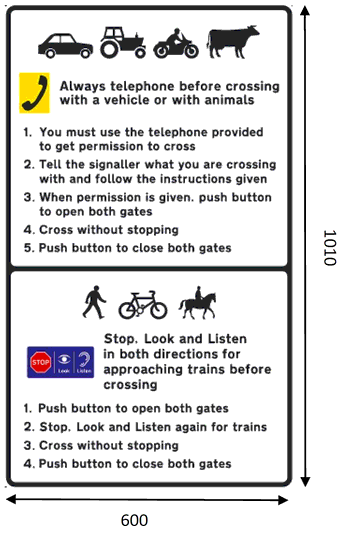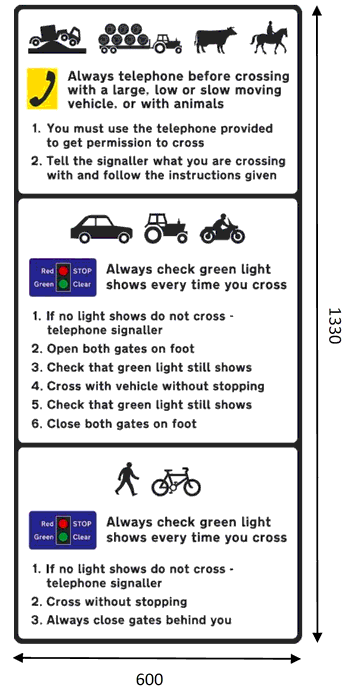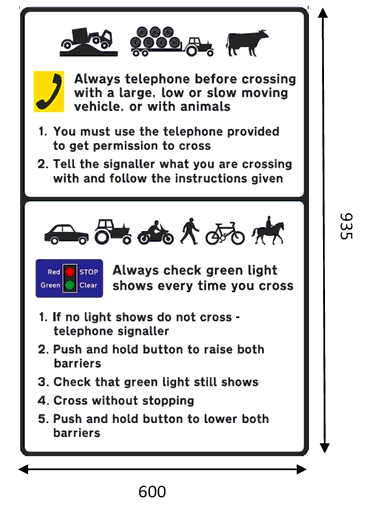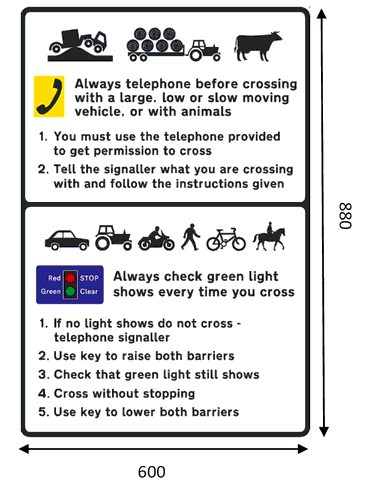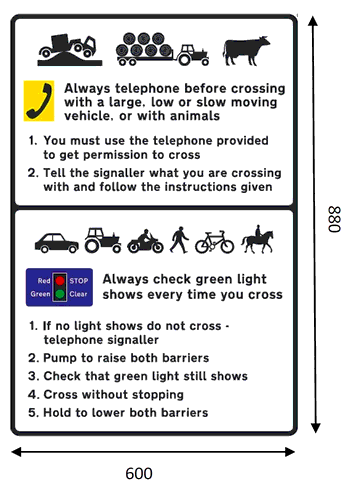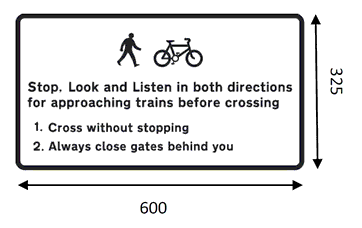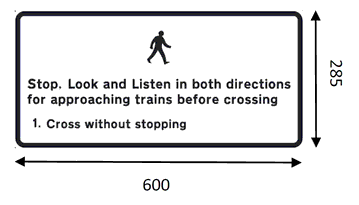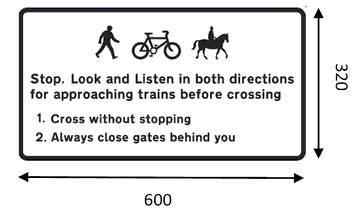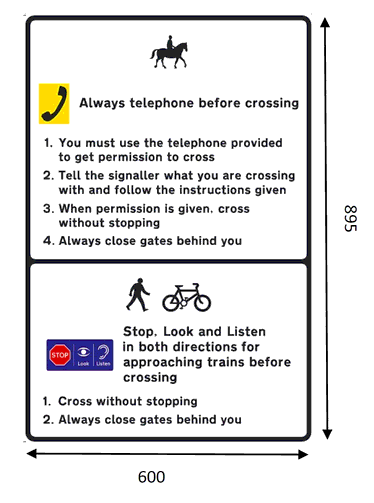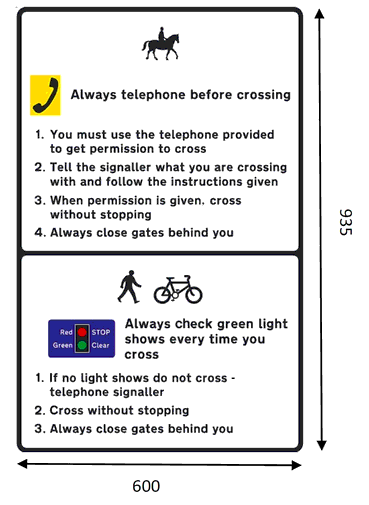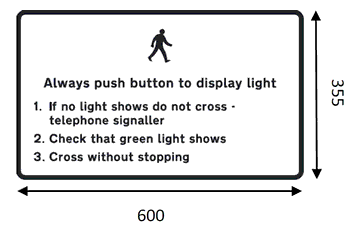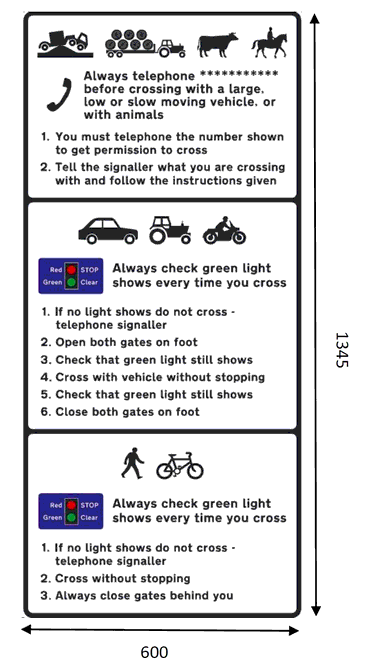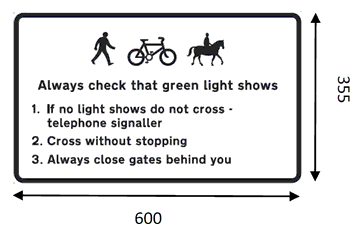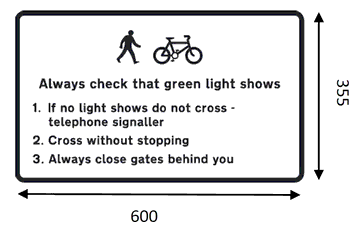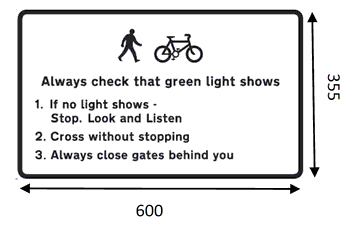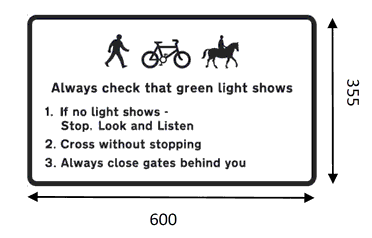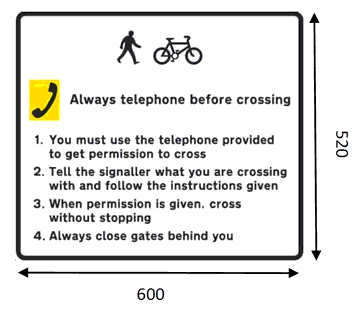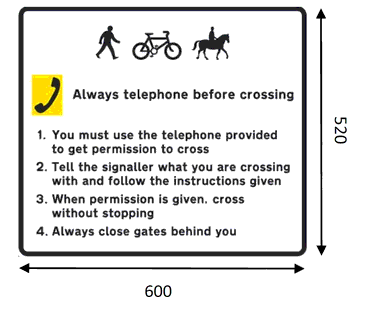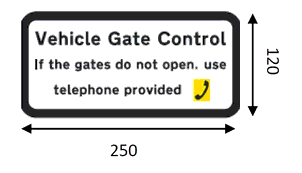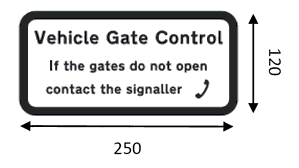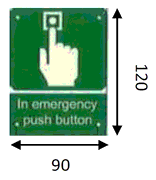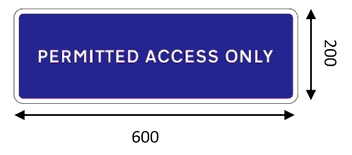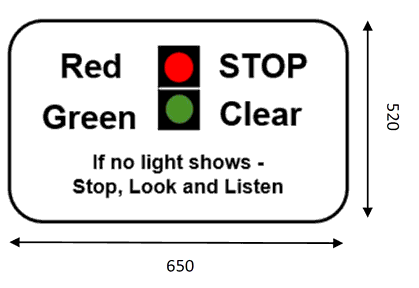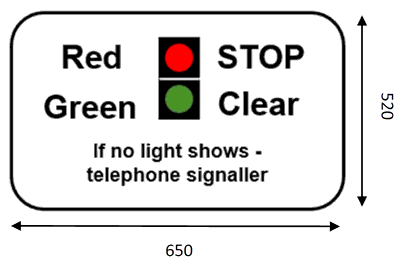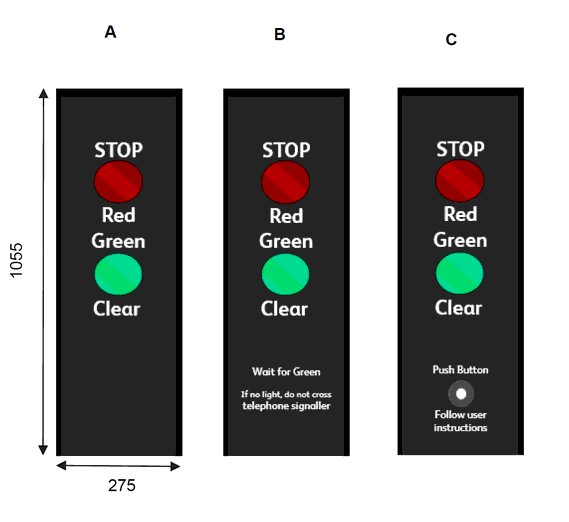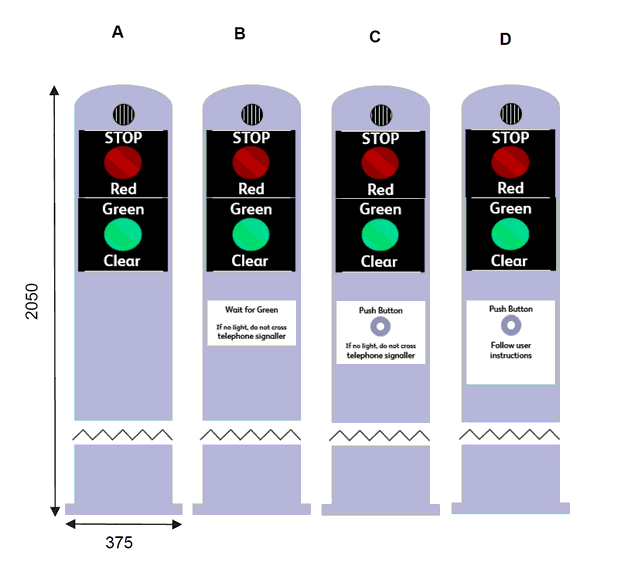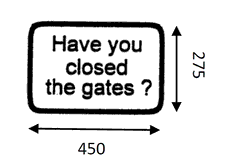- Latest available (Revised)
- Original (As made)
The Private Crossings (Signs and Barriers) Regulations 2023
You are here:
- UK Statutory Instruments
- 2023 No. 1112
- Schedules only
More Resources
Status:
This is the original version (as it was originally made).
Regulation 3
Schedule 1Crossing signs
Part 1Warning signs
Diagram 106 Permitted variants A or B: On sign B, the telephone number for the signaller must be provided at crossings with no fixed telephones.
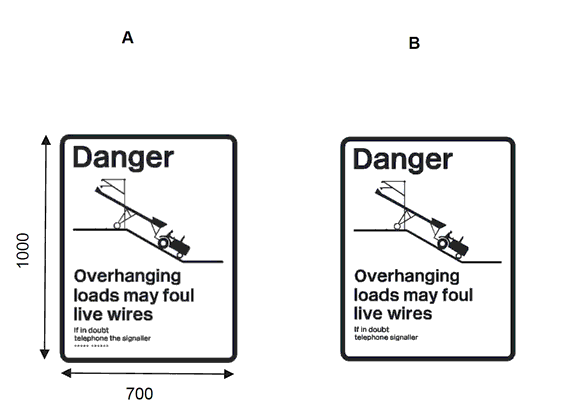
Part 2Summary signs and stop sign
Part 3Instruction signs
Part 4Miniature stop light instructions and units
Part 5Information signs
Diagram 164: Permitted variant: the appropriate variant (A, B, C, or D) may be placed according to the circumstances at the crossing.
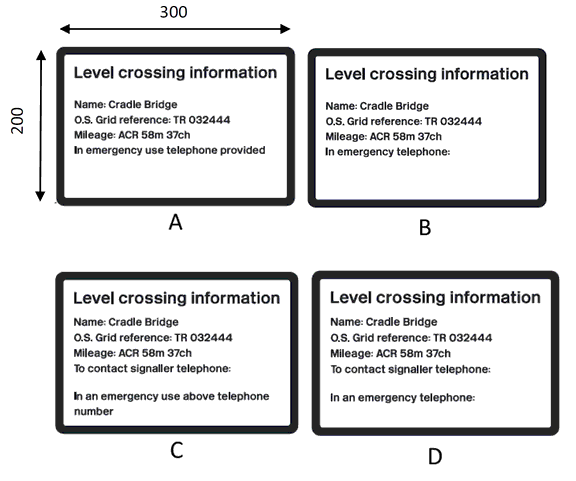
Part 6Reminder signs
Regulation 10
Schedule 2Gates
1. A gate must, by itself or with another gate on the same side of the railway or tramway, be long enough to extend across the full width of the relevant road.
2. Where gates are placed, they must pivot to open away from the railway or tramway.
3. When a gate is closed, the top surface of the gate must be a minimum of 1350 millimetres above the road surface at the centre of the relevant road.
4. The underclearance between each gate and the road must not exceed 150 millimetres. If the relevant road is an unmetalled track, the underclearance between the gate and the road may be greater than 150 millimetres only if necessary to avoid the gate grounding during opening and closing.
5. Where a gate is installed otherwise than for the sole use of pedestrians, it must have a way to secure it in the open and in the closed positions.
6. A gate must be as light in weight as possible but nevertheless strong enough to withstand distortion or breakage caused by wind pressure or by a farm animal.
Regulation 10
Schedule 3Barriers other than gates
1.—(1) Where a barrier, other than a gate, is placed, it must when lowered across the relevant road be long enough to extend either—
(a)across the full width of the relevant road, or
(b)subject to paragraph (2), from the left-hand side of the relevant road (as seen from a vehicle approaching the crossing) to a point as close as possible to the centre of the relevant road.
(2) In a case falling within paragraph (1)(b), there must be a minimum distance of 3 metres from the tip or, as the case may be, vertical edge of the barrier to the other side of the relevant road to allow clear passage.
2. When a barrier is lowered its top surface must be a minimum height of 900 millimetres above the road surface at the centre of the relevant road.
3. The underclearance between the barrier when lowered and the road surface must not exceed 1000 millimetres.
4. A barrier must have means to raise it, and hold it in the raised position. It must also have means to release the hold and allow the barrier to return to a horizontal position.
5. A barrier may be linked with another barrier at the crossing to allow all the barriers to be raised or lowered simultaneously from either side of the crossing.
6. The pivot post of a barrier must be covered to avoid injury to persons using it.
7. A barrier must have on both front and rear faces alternate red and white bands each approximately 600 millimetres wide (measured horizontally across the face of the barrier) and to the full depth of the barrier measured vertically on the full face of the barrier when horizontal. A strip of retroreflecting material not less than 50 millimetres deep, in a colour matching that of the bands must be attached along the full width of each band.
8. A barrier may be fitted with a skirt which fills the space between the barrier and the road surface. Any skirt must be light in colour.
9. Electric lights may be fitted to a barrier and each light must show a red light, when illuminated, in each direction along the relevant road.
10. A barrier, with or without a skirt if fitted, must be as lightweight as possible but nevertheless—
(a)a barrier must be strong enough to withstand distortion or breakage, and
(b)a skirt fitted to a barrier must be capable of withstanding damage
caused by wind pressure or by a farm animal.
Options/Help
Print Options
PrintThe Whole Instrument
PrintThe Schedules only
Legislation is available in different versions:
Latest Available (revised):The latest available updated version of the legislation incorporating changes made by subsequent legislation and applied by our editorial team. Changes we have not yet applied to the text, can be found in the ‘Changes to Legislation’ area.
Original (As Enacted or Made): The original version of the legislation as it stood when it was enacted or made. No changes have been applied to the text.
Explanatory Memorandum
Explanatory Memorandum sets out a brief statement of the purpose of a Statutory Instrument and provides information about its policy objective and policy implications. They aim to make the Statutory Instrument accessible to readers who are not legally qualified and accompany any Statutory Instrument or Draft Statutory Instrument laid before Parliament from June 2004 onwards.
More Resources
Access essential accompanying documents and information for this legislation item from this tab. Dependent on the legislation item being viewed this may include:
- the original print PDF of the as enacted version that was used for the print copy
- lists of changes made by and/or affecting this legislation item
- confers power and blanket amendment details
- all formats of all associated documents
- correction slips
- links to related legislation and further information resources
More Resources
Use this menu to access essential accompanying documents and information for this legislation item. Dependent on the legislation item being viewed this may include:
- the original print PDF of the as made version that was used for the print copy
- correction slips
Click 'View More' or select 'More Resources' tab for additional information including:
- lists of changes made by and/or affecting this legislation item
- confers power and blanket amendment details
- all formats of all associated documents
- links to related legislation and further information resources
